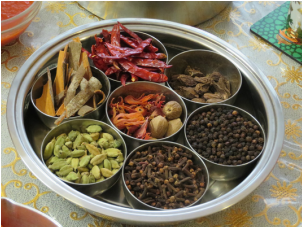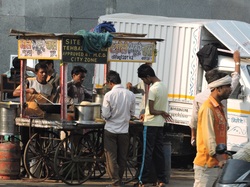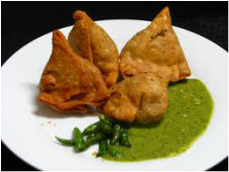
How fortunate we are to have Indian immigrants in America. (We are referring to people from southern Asia, as Native Americans are not immigrants, nor are they Indians.) Indian cuisine is ancient and highly sophisticated. It incorporates complex spice mixes into a healthy and well-balanced diet that includes nutritious legumes and lots of fresh vegetables. Since Indian restaurants and snack shops are now ubiquitous in the United States and Canada, we recommend that you order most of the food for this tea party at a good Indian restaurant. You can make the beverages and sauces yourself and serve them with the purchased food when the guests arrive. We also offer a recipe for Vegetable Samosas for anyone who wants to make these irresistible savory pastries at home.
Of course we encourage you to dine at several Indian restaurants in your local area and change this menu according to your own preferences. If you have never before eaten Indian food, order a Thali dinner, which will give you a small taste of a variety of savory and sweet dishes and sauces, from which you can select some of your favorites when it is time to plan your Indian Chai Party. However, keep in mind that a tea party is not a dinner, and our Chai Party will include small servings of savory foods, breads and sweets, as most tea parties do.
Rose recently returned from an intensive tour of India, where she experienced many culinary delights, from street food in the Old Delhi spice markets to a gourmet meal at Ziya, a Michelin-starred Indian fusion restaurant at the Oberoi Hotel in Mumbai. She also experienced “high tea” at Banjaar Tola, a safari camp in Kanha National Park, one of India’s largest wildlife preserves, where a staff of highly trained chefs provides gourmet Indian meals for all of the guests. In addition, Rose and her husband took a cooking class in New Delhi (contact [email protected] for information,) where they learned to make the Green Chutney included in this menu among several other fabulous Indian dishes. The most encouraging food related news Rose brought back from India is the affirmation that most Indian families still eat three home cooked meals a day, all freshly prepared from natural ingredients, and Indians avoid eating leftovers whenever possible.
Of course we encourage you to dine at several Indian restaurants in your local area and change this menu according to your own preferences. If you have never before eaten Indian food, order a Thali dinner, which will give you a small taste of a variety of savory and sweet dishes and sauces, from which you can select some of your favorites when it is time to plan your Indian Chai Party. However, keep in mind that a tea party is not a dinner, and our Chai Party will include small servings of savory foods, breads and sweets, as most tea parties do.
Rose recently returned from an intensive tour of India, where she experienced many culinary delights, from street food in the Old Delhi spice markets to a gourmet meal at Ziya, a Michelin-starred Indian fusion restaurant at the Oberoi Hotel in Mumbai. She also experienced “high tea” at Banjaar Tola, a safari camp in Kanha National Park, one of India’s largest wildlife preserves, where a staff of highly trained chefs provides gourmet Indian meals for all of the guests. In addition, Rose and her husband took a cooking class in New Delhi (contact [email protected] for information,) where they learned to make the Green Chutney included in this menu among several other fabulous Indian dishes. The most encouraging food related news Rose brought back from India is the affirmation that most Indian families still eat three home cooked meals a day, all freshly prepared from natural ingredients, and Indians avoid eating leftovers whenever possible.

About Spices: The Spice Box
Indian food incorporates a large number of spices to create taste effects that include sweet, sour, salty and hot, often in the same dish. Spices are also selected for their medicinal effects according to the ancient Ayervedic tradition. Spices included in Indian food can have antiseptic qualities, aid digestion, assist with healthy kidney function, improve circulation or provide a variety of other health benefits. Indian chefs feel strongly that spices used for cooking should be freshly ground by hand with a mortar and pestle or in a spice grinder.
Every Indian cook (usually the wife and mother of the family) owns a spice box, a round metal container with a tightly fitting lid containing seven smaller metal bowls of the following freshly ground spices:
Indian food incorporates a large number of spices to create taste effects that include sweet, sour, salty and hot, often in the same dish. Spices are also selected for their medicinal effects according to the ancient Ayervedic tradition. Spices included in Indian food can have antiseptic qualities, aid digestion, assist with healthy kidney function, improve circulation or provide a variety of other health benefits. Indian chefs feel strongly that spices used for cooking should be freshly ground by hand with a mortar and pestle or in a spice grinder.
Every Indian cook (usually the wife and mother of the family) owns a spice box, a round metal container with a tightly fitting lid containing seven smaller metal bowls of the following freshly ground spices:
- Cumin
- Chili powder
- Kashmiri chili (mirch)
- Salt
- Turmeric
- Coriander powder
- Dry mango powder

The Indian cook will also own a second spice box containing whole spices that can be freshly ground or added whole to food while it is being prepared:
The well known spice mix known as garam masala, which is added to many Indian dishes, is a ground combination of the seven whole spices in the second spice box.
- Cinnamon bark
- Green cardamom pods
- Cloves
- Mace (from the nutmeg plant)
- Black peppercorns
- Black cardamom pods
- Red chili pods
The well known spice mix known as garam masala, which is added to many Indian dishes, is a ground combination of the seven whole spices in the second spice box.

The Tandoor: A Brilliant Invention
A Tandoor is a cylindrical clay or metal oven used for baking and cooking. Traditionally, the tandoor was heated by charcoal or wood burning within the oven itself, and temperatures could reach 900° F. This ancient invention allowed the food to be cooked very quickly using live-fire radiant heat cooking, hot-air convection cooking, and smoking from the fat and food juices that dripped onto the wood or charcoal. Indian cooks today still use the tandoor to cook meats or vegetables inserted into the oven on long metal skewers and flat breads, such as nan, roti, paratha and kulcha, which adhere to the side of the tandoor as they bake. We are guessing that most of our readers do not own a tandoor, another reason why we recommend buying the papadum, tandoori chicken, kabuli nan and onion kulcha from a good Indian restaurant which does have a tandoor.
A Tandoor is a cylindrical clay or metal oven used for baking and cooking. Traditionally, the tandoor was heated by charcoal or wood burning within the oven itself, and temperatures could reach 900° F. This ancient invention allowed the food to be cooked very quickly using live-fire radiant heat cooking, hot-air convection cooking, and smoking from the fat and food juices that dripped onto the wood or charcoal. Indian cooks today still use the tandoor to cook meats or vegetables inserted into the oven on long metal skewers and flat breads, such as nan, roti, paratha and kulcha, which adhere to the side of the tandoor as they bake. We are guessing that most of our readers do not own a tandoor, another reason why we recommend buying the papadum, tandoori chicken, kabuli nan and onion kulcha from a good Indian restaurant which does have a tandoor.

Spicy and Hot: Not the Same Thing
On her recent trip to India, Rose was just a little saddened to see so many American and Canadian tourists asking for bacon and eggs for breakfast (or worse, hamburgers for lunch,) and exclaiming loudly, “Is this hot? I don’t like spicy foods!” First of all, hot and spicy are two different taste experiences. Many spices, such as cumin, cardamom and cloves, are not “hot” at all when added to food. And chili and other “hot” spices are often tempered in Indian cuisine by being served with raita, a yogurt and fresh vegetable sauce that has a cooling effect on foods that are cooked with chilies. Rice and nan (Indian bread,) are also usually only lightly spiced and can reduce the “hot” effect of many Indian food preparations.
We encourage our readers who are not familiar with Indian food to embrace this ancient and healthy food tradition with an open mind and a sense of culinary wonder and adventure. We also ask for cultural sensitivity, as Indian food, like Kosher food and many other food traditions, has religious implications. The vast majority of Indians adhere to the Hindu religion, where cows are cherished and revered and never eaten. Even McDonald’s does not serve hamburgers in India. When we respect other people’s spiritual values, they will respect ours.
On her recent trip to India, Rose was just a little saddened to see so many American and Canadian tourists asking for bacon and eggs for breakfast (or worse, hamburgers for lunch,) and exclaiming loudly, “Is this hot? I don’t like spicy foods!” First of all, hot and spicy are two different taste experiences. Many spices, such as cumin, cardamom and cloves, are not “hot” at all when added to food. And chili and other “hot” spices are often tempered in Indian cuisine by being served with raita, a yogurt and fresh vegetable sauce that has a cooling effect on foods that are cooked with chilies. Rice and nan (Indian bread,) are also usually only lightly spiced and can reduce the “hot” effect of many Indian food preparations.
We encourage our readers who are not familiar with Indian food to embrace this ancient and healthy food tradition with an open mind and a sense of culinary wonder and adventure. We also ask for cultural sensitivity, as Indian food, like Kosher food and many other food traditions, has religious implications. The vast majority of Indians adhere to the Hindu religion, where cows are cherished and revered and never eaten. Even McDonald’s does not serve hamburgers in India. When we respect other people’s spiritual values, they will respect ours.
Menu
Beverages:
Hot Chai
Sweet Lassi
Mango Lassi (Lassi is a yogurt-based beverage served cold.)
Savories:
Vegetable Samosas (Savory Fried Pastries with Potato and Pea Filling)
Papadum (Lentil Crackers) with Tamarind Chutney
Tandoori Chicken Skewers
Kabuli Naan (Flat Bread with Raisins and Cashews)
Onion Kulcha with Chole (Round Leavened Wheat Bread with Chickpea Curry
Additional Condiments:
Green Chutney
Raita (Savory Yogurt with Shredded Cucumbers)
Sweets:
Gulab Jamun (Round Dumplings Soaked in Syrup)
Keer (Indian Rice Pudding. Serve this delicious and healthy treat in small individual cups or bowls.)
Gajar Ka Halwa (Pakastani-Style Carrot Pudding)
Beverages:
Hot Chai
Sweet Lassi
Mango Lassi (Lassi is a yogurt-based beverage served cold.)
Savories:
Vegetable Samosas (Savory Fried Pastries with Potato and Pea Filling)
Papadum (Lentil Crackers) with Tamarind Chutney
Tandoori Chicken Skewers
Kabuli Naan (Flat Bread with Raisins and Cashews)
Onion Kulcha with Chole (Round Leavened Wheat Bread with Chickpea Curry
Additional Condiments:
Green Chutney
Raita (Savory Yogurt with Shredded Cucumbers)
Sweets:
Gulab Jamun (Round Dumplings Soaked in Syrup)
Keer (Indian Rice Pudding. Serve this delicious and healthy treat in small individual cups or bowls.)
Gajar Ka Halwa (Pakastani-Style Carrot Pudding)
|
Recipes Included:
Hot Chai (Indian Spiced Milk Tea) Chai is an aromatic, spicy hot tea. It is served with milk and sweetened lightly with brown sugar. Although pre-packaged chai is available at any grocery store, you can make your own elegant chai using this easy recipe. Check your spice rack before you start to make sure you have all of the spices needed for this lovely elixir. Not everyone keeps cardamom in the cupboard, but you can find this sweet and subtle spice in any Indian market, or even in a Scandinavian deli, as cardamom is also a popular addition to Nordic breads and pastries. Sweet Lassi Lassi is a healthy and refreshing yogurt drink. It is the perfect beverage for hot weather, and it provides a nice mild balance to complement spicy Indian food. Lassi is subtly flavored with small amounts of powdered cardamom and rose water and mixed in the blender with ice cubes. It is so easy to make that you can whip it up even after your guests have arrived. We recommend serving it immediately in tall glasses while it is still icy. This recipe makes two to three servings, but you can make two batches very quickly or double the ingredients. Just make sure that you don’t overfill your blender. For a festive presentation, you can top each serving with a few sprinkles of finely chopped pistachios or almonds. Mango Lassi The taste and bright tropical aroma of fresh mangos pair beautifully with Sweet Lassi. Mango Lassi is a popular variation of Sweet Lassi and a favorite accompaniment to Indian food. It is essentially just Sweet Lassi with fresh mango pulp added to the mix. For your Indian Afternoon Tea, you might want to make a batch of each, starting with the Sweet Lassi, then making the Mango Lassi. This way, you will not need to clean the blender between batches, and your guests will have a choice of beverages. There seems to be no absolute rule about how much mango pulp to add to the Lassi mix, with recipes varying from two to four mangos added per batch. We think two mangos are more than enough, but if you and your guests are crazy for mangos, don’t hesitate to add more. Vegetable Samosas Samosas are pyramid shaped savory pastries filled with spiced vegetables, chicken or lamb. They can be baked in a tandoor or fried. Our version will be baked in your own oven. You can always buy fresh Samosas in an Indian restaurant or snack shop, but we offer this recipe for our readers who would like to make them at home. You will notice that Samosas are similar to the Pasties that were included in our Irish St. Patrick’s Day Tea. Traditional Samosas are made using ghee, a specialized type of clarified butter made from unpasteurized cow’s milk and used in Indian cooking and religious ceremonies for the past 5,000 years. You can purchase prepared ghee from an Indian grocery or order it from amazon.com. You can also just use butter or oil to make these Samosas. For the entire recipe, you will need about 1 ½ sticks of melted butter. Green Chutney This bright tasting, uncooked sauce will be delicious served in a small bowl to be spooned over the Samosas. The fresh cilantro and mint leaves give this condiment an intense green color and vibrant flavor, but this sauce does have a little kick from the green chilies, so let your guests be warned. Tamarind Chutney Tamarind is used to make candies, soda pop and other sweets in India, other areas of Southeast Asia, Mexico and Hawaii. The fresh fruit is somewhat fibrous and filled with seeds, so you might want to make your Tamarind Chutney from tamarind paste, which is available at Indian markets and from Amazon.com. Tamarind Chutney is both sweet and spicy and will complement the Papadum (Lentil Crackers) that you will be serving with the savory course of your Indian Chai Party. It is also good on Samosas and any of the Indian breads. It keeps well in the refrigerator for several weeks. Raita (Savory Yogurt and Cucumber Sauce) Raita is served as a condiment with almost all Indian meals. It is made of yogurt, which is a primary source of protein in Indian cuisine. Small amounts of fresh vegetables and spices are added to Raita to enhance its nutritional value and to harmonize with the other dishes being served. You can put Raita on almost any of the savory dishes on your Chai Party menu, from the Samosas to the Tandoori Chicken to the Indian breads. Raita can be made a day or two in advance and refrigerated until ready to serve. |









